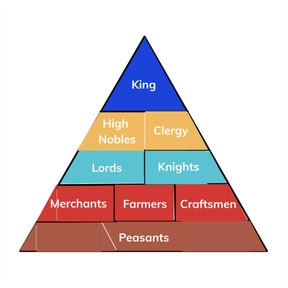
Introduction to The Middle Ages
I can describe the basic government and society during the European Middle Ages.



8,000 schools use Gynzy
92,000 teachers use Gynzy
1,600,000 students use Gynzy
General
Students are given an introduction to the Middle Ages, in which they learn about the feudal system, and about the power positions of people in that time.
Standards
CCSS.ELA-Literacy.RI.6.1
CCSS.ELA-Literacy.RI.6.3
CCSS.ELA-Literacy.RI.6.7
CCSS.ELA-Literacy.RI.7.1
CCSS.ELA-Literacy.RI.7.3
CCSS.ELA-Literacy.RI.8.1
CCSS.ELA-Literacy.RI.8.3
Learning objective
Students will be able to describe basic government and society in Europe during the Middle Ages.
Introduction
Have students discuss their prior knowledge or ideas about the Middle Ages in groups or pairs. Discuss some of their ideas as a class. Start by showing students the timeline of history on the interactive whiteboard. Help them find where the Middle Ages fall on this timeline. Explain to students that it is important to learn about the Middle Ages to understand how human behavior changes over time and to relate history to the period in which we live today. Refer to the name "Dark Ages" and explain that this is an older understanding of this time, but it was a time of great influence for the Church. Have students drag the periods of history to where they belong on the timeline.
Instruction
Introduce students to the basics of government in the Middle Ages, and explain that the lack of a single unified government led to the feudal system. Emphasize that it was a top-down system in which rights or privileges were granted to people depending on where they were in the system. All of these rights and privileges were based on land ownership. What was on the land? The center of life was the Manor. Manor houses became the nucleus of small villages acting as the central hub. Define and explain the function of the key houses and buildings that would be found in a small village. Have students determine which definitions match with each of the given pictures to check their understanding of the manor. Next, explain the rigid social structure of the Middle Ages. Go through each of the levels of the social hierarchy and explain what life might have been like and show a representative image. Finish by explaining the role of children during the Middle Ages. Be sure to explain that "childhood" and being free to play are relatively current understandings, and that children started (some form of) work quite early. Have students decide in pairs (or groups) which group of people were most important and why. As a class, have students recreate the social hierarchy pyramid.
Quiz
Students are given a mix of true/false, multiple-choice, and fill in the blank questions to check understanding of key concepts taught during the lesson.
Closing
Discuss the learning goal with the students and challenge students to answer the questions given. Close by asking students to match the person to their class description. Answers are provided under covers.
The online teaching platform for interactive whiteboards and displays in schools
Save time building lessons
Manage the classroom more efficiently
Increase student engagement
Discover more!
About Gynzy
Gynzy is an online teaching platform for interactive whiteboards and displays in schools.
With a focus on elementary education, Gynzy’s Whiteboard, digital tools, and activities make it easy for teachers to save time building lessons, increase student engagement, and make classroom management more efficient.



